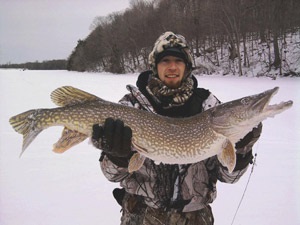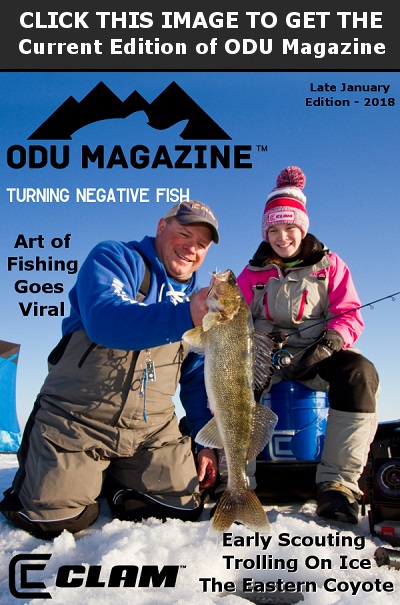 Ice fishing opportunities abound in New York State. Winter anglers catch a variety of fish; primarily perch, sunfish, pickerel, northern pike and walleye. In addition, many waters throughout New York State are open to fishing for trout, lake trout and landlocked salmon. Check the “Special Regulations By County” sections of the Fishing Regulations Guide (link below).
Ice fishing opportunities abound in New York State. Winter anglers catch a variety of fish; primarily perch, sunfish, pickerel, northern pike and walleye. In addition, many waters throughout New York State are open to fishing for trout, lake trout and landlocked salmon. Check the “Special Regulations By County” sections of the Fishing Regulations Guide (link below).
Fishing through the ice requires skill and knowledge as does open water angling. But, anyone can ice fish successfully if he/she does the homework. Learning about the water to be fished, the equipment and its capabilities, proper clothing and safety precautions are all part of a successful, enjoyable winter fishing experience. Perhaps the best way to get started is to accompany a friend or neighbor on a half-day ice fishing outing. If you are unable to locate anyone to go with, the next best alternative is to visit a tackle shop in a popular ice fishing area. The proprietors are interested in seeing that you have a successful and enjoyable trip and will provide you with all of the necessary equipment. You may also watch for announcements of local ice fishing contests or tournaments run by local sportsmen’s clubs — ice fishermen tend to be a highly social group, eager to share tips, techniques and stories.
For a first trip, try to pick an opportune weather day — remember those blustery January days will soon fade into mild February and spring-like March days which often provide some of the most productive ice fishing of the season. Whatever the day you decide to go ice fishing, be sure to check the ice for safety.
The Waters . . .
Most all ponds and lakes offer ice fishing potential. Their characteristics define the kinds of fish that may be caught. Large, shallower ponds and lakes favor species such as chain pickerel, northern pike, yellow perch and sunfish. Deepwater lakes need to be fished selectively to get good catches of northern pike, walleye or lake trout. Brown trout, rainbow trout and landlocked salmon, where they may legally be taken, are often found in deep lakes, which provide necessary cool temperatures in the summertime. However, when these lakes are ice-covered, trout are frequently caught while cruising just a few feet under the ice. The local tackle shop where you purchase your bait should be able to advise you on where fish are currently being caught.
 Regardless of the fish species that you are seeking, concentrations of anglers or the presence of many old holes will provide an indication of areas where good catches have recently occurred.
Regardless of the fish species that you are seeking, concentrations of anglers or the presence of many old holes will provide an indication of areas where good catches have recently occurred.
Cutting the Ice…
Getting through the ice is not as hard as it might seem. There are a variety of tools available that make this “essential task” fairly simple. Perhaps the simplest is an old-fashioned “spud” bar which your grandfather may have used on his ice fishing trips. Spuds are often the cheapest way to cut a hole in the ice and work reasonably well on ice up to about a foot thick. Hand-powered augers, which are slightly more expensive than spud bars, are easy to operate and offer the best all-around compromise for moderate ice conditions. Try to purchase an auger appropriate to the species of fish that you are seeking. Anglers who fish for yellow perch, sunfish and other pan fish frequently favor ice augers 4″, 5″ or 6″ in diameter because of their light weight and the speed that they bore through the ice. Anglers who fish for larger fish, such as trout, lake trout, landlocked salmon and northern pike, frequently prefer an ice auger which will make a larger hole — an appreciated feature during the often-tricky landing of these large fish. But remember, cutting an 8″ hole requires the removal of almost twice as much ice as a 6″ hole, so don’t buy an ice auger much bigger than you will need. For the avid ice angler or for thicker, more extreme ice conditions, more expensive, gas-powered augers provide the ultimate in speed and convenience, albeit at a sacrifice in weight and portability. Power augers come in diameters up to 10″ and the size of the hole makes little difference in the speed or difficulty of cutting the hole.
Ice Fishing Methods…
Ice fishing methods include “jigging” with short, light fishing rods and using tip-ups. There are many different kinds of jigging poles and tip-ups. Much of the equipment is easy to make.
Jigging involves the use of a jigging rod or hand line and a small jigging spoon or lure which is often “sweetened” with a piece of bait. The jig is designed to dart around in different directions when it is jerked up and down by the angler.
The tip-up is basically a spool on a stick holding a baited line suspended through a hole in the ice. When the bait – usually a minnow – is taken by a fish, the pull on the line releases a signal, such as a red flag.
Clothing…
For safe ice fishing outings, anglers need to be well prepared. Proper clothing is critical because most people do not move around much while ice fishing. Dress warmly, paying extra attention to your head, feet and hands – dressing in layers is essential.
Ice safety…
Safe ice is the number one consideration. A minimum of three to four inches of solid ice is the general rule for safety. Ice thickness, however, is not uniform on any body of water. The guidelines presented here (based on Minnesota Department of Natural Resources) are based on new clear ice on non-running waters. Remember, your own good judgment is essential! Since ice thickness can vary on a lake, check the ice periodically to stay safe.
| Ice Thickness | Permissible Load |
|---|---|
| 2 inches or less | Stay Off |
| 4 inches | Ice fishing or other activities on foot |
| 5 inches | Snowmobile or ATV |
| 8-12 inches | Car or small pickup |
| 12-15 inches | Medium truck |
Note: This guide is based on new, clear ice on non-running waters. Slush ice is about 50 percent weaker. Clear, ice over running water is about 20 percent weaker. Double the recommendations for white ice. Many ice anglers do not like to fish on less than five inches of ice, and do not like to drive a pick-up truck on less than 15 inches of ice. Use common sense!
Be cautious in areas where “bubblers” are used to protect docks. They can produce thin, unsafe ice some distance away. Be especially alert in areas near shore, over moving bodies of water and on lakes and ponds where streams enter or exit.
Remember, use the buddy system while ice fishing – it saves lives.
And, last but not least, the fishing regulations…
Review the ice fishing regulations to let you know where you can ice fish, how many lines you are permitted, and information about the use of ice shanties.
Region 3 Ice Fishing
- Ice Fishing in Dutchess County
- Ice Fishing In Orange County
- Ice Fishing in Putnam County
- Ice Fishing in Rockland County
- Ice Fishing in Sullivan County
- Ice Fishing in Ulster County
- Ice Fishing in Westchester County
For more information on ice fishing in Region 3, call 845-256-3161.
Region 4 Ice Fishing
- Ice Fishing in Albany County
- Ice Fishing in Columbia County
- Ice Fishing in Delaware County
- Ice Fishing in Greene County
- Ice Fishing in Otsego County
- Ice Fishing in Rensselaer County
- Ice Fishing in Schenectady County
- Ice Fishing in Schoharie County
For more information on ice fishing in Region 4, call 607-652-7366
Region 5 Ice Fishing
- Clinton County Ice Fishing
- Essex County Ice Fishing
- Franklin County Ice Fishing
- Fulton County Ice Fishing
- Hamilton County Ice Fishing
- Saratoga County Ice Fishing
- Warren County Ice Fishing
- Washington County Ice Fishing
For more information on ice fishing in Region 5, call 518-897-1333.
Region 6 Ice Fishing
- Ice Fishing Perch Lake
- Ice Fishing in Region 6
For more information on ice fishing in Region 6, call 315-785-2263.
Region 7 Ice Fishing
- Ice Fishing in Broome County
- Ice Fishing in Cayuga County
- Ice Fishing in Chenango County
- Ice Fishing in Cortland County
- Ice Fishing in Madison County
- Ice Fishing in Onondaga County
- Ice Fishing in Oswego County
- Ice Fishing in Tioga County
- Ice Fishing in Tompkins County
For more information on ice fishing in Region 7, call 607-753-3095.
Region 8 Ice Fishing
- Ice Fishing in Chemung County
- Ice Fishing in Livingston County
- Ice Fishing in Monroe County
- Ice Fishing in Ontario County
- Ice Fishing in Orleans County
- Ice Fishing in Schuyler County
- Ice Fishing in Seneca County
- Ice Fishing in Steuben County
- Ice Fishing in Wayne County
- Ice Fishing in Yates County
For more information on ice fishing in Region 8, call 585-226-2466.
Region 9 Ice Fishing
- Ice Fishing in Allegany County
- Ice Fishing in Cattaraugus County
- Ice Fishing in Chautauqua County
- Ice Fishing in Erie County
- Ice Fishing in Niagara County
- Ice Fishing in Wyoming County
For more information on ice fishing in Region 9, call 716-372-0645.
